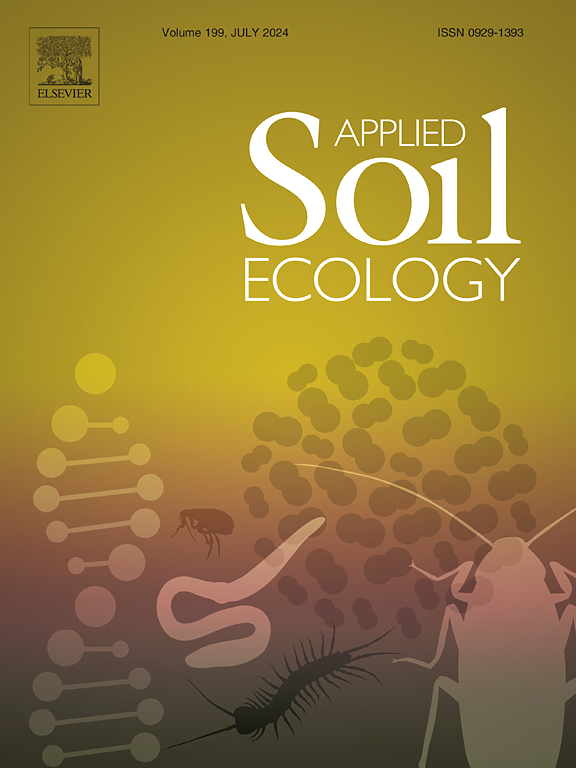Short-term effects of co-applied biochar and paper mill biosolids on soil microbial communities under field conditions
IF 4.8
2区 农林科学
Q1 SOIL SCIENCE
引用次数: 0
Abstract
Biochar and paper mill biosolids (PB) are reported to improve soil fertility, crop growth and indirectly conditions for soil microbial communities. However, it is unclear how the co-application of these materials impacts soil microbial communities under field conditions. A study was initiated in 2018 in Québec, QC, Canada and fine roots and rhizosphere soil were sampled to determine the effects of co-application of wood biochar (0, 10, and 20 Mg dry wt. ha−1) and PB (0 and 30 Mg wet wt. ha−1) on the percentage of corn (Zea mays L.) and soybean (Glycine max L. Merr.) root colonization by arbuscular mycorrhizal fungi (AMF), soil microbial biomass phosphorus (MBP) and microbial (Bacteria, Fungi and AMF) diversity and community structure in a temperate loamy soil. Co-applying PB and biochar increased soil MBP compared with the control and biochar-only application. Applying PB alone or with biochar increased the level of root colonization by AMF compared with the control and biochar-only application in soybean but not in corn. Overall, biochar and PB application had no significant effect on bacterial and AMF diversity and community structure compared with the control. However, applying PB alone or with biochar decreased the fungal alpha diversity (Shannon and Simpson indices), affected several fungal taxa abundances and shifted the fungal community structure as indicated by the principal coordination analysis (PCoA). Our results provided an understanding on the short-term effects of co-applied wood biochar and PB on microbial communities of a temperate loamy soil under field conditions, as well as scientific bases for further investigation.
在野外条件下共同施用生物炭和造纸厂生物固体对土壤微生物群落的短期影响
据报道,生物炭和造纸厂生物固体(PB)可改善土壤肥力、作物生长和土壤微生物群落的间接条件。然而,目前还不清楚在田间条件下共同施用这些材料会对土壤微生物群落产生怎样的影响。2018 年在加拿大魁北克省启动了一项研究,对细根和根瘤土壤进行了取样,以确定共同施用木质生物炭(0、10 和 20 兆克干重/公顷-1)和 PB(0 和 30 兆克湿重/公顷-1)对玉米(Zea mays L.)和大豆(Glycine max L. Merr.)根部丛枝菌根真菌(AMF)定殖率、土壤微生物生物量磷(MBP)以及温带壤土中微生物(细菌、真菌和 AMF)多样性和群落结构的影响。与对照组和只施用生物炭的对照组相比,共同施用 PB 和生物炭可增加土壤的生物量磷。与对照组和只施用生物炭的大豆相比,单独施用 PB 或与生物炭一起施用可提高 AMF 在大豆根部的定殖水平,但在玉米中却没有提高。总体而言,与对照组相比,施用生物炭和 PB 对细菌和 AMF 的多样性和群落结构没有显著影响。然而,单独施用生物碳或同时施用生物碳会降低真菌的α多样性(香农指数和辛普森指数),影响多个真菌类群的丰度,并改变真菌群落结构(如主配位分析(PCoA)所示)。我们的研究结果让人们了解了在野外条件下共同施用木质生物炭和 PB 对温带壤土微生物群落的短期影响,并为进一步研究提供了科学依据。
本文章由计算机程序翻译,如有差异,请以英文原文为准。
求助全文
约1分钟内获得全文
求助全文
来源期刊

Applied Soil Ecology
农林科学-土壤科学
CiteScore
9.70
自引率
4.20%
发文量
363
审稿时长
5.3 months
期刊介绍:
Applied Soil Ecology addresses the role of soil organisms and their interactions in relation to: sustainability and productivity, nutrient cycling and other soil processes, the maintenance of soil functions, the impact of human activities on soil ecosystems and bio(techno)logical control of soil-inhabiting pests, diseases and weeds.
 求助内容:
求助内容: 应助结果提醒方式:
应助结果提醒方式:


